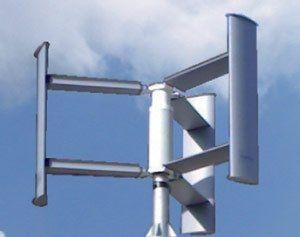EnergyA second look at off-shore use of vertical-axis wind turbines
Wind energy researchers are re-evaluating vertical axis wind turbines (VAWTs) to help solve some of the problems of generating energy from offshore breezes; though VAWTs have been around since the earliest days of wind energy research, VAWT architecture could transform offshore wind technology

One of many designs of vertical wind turbines // Source: spazioenergia.it
Sandia National Laboratories’ wind energy researchers are re-evaluating vertical axis wind turbines (VAWTs) to help solve some of the problems of generating energy from offshore breezes.
Though VAWTs have been around since the earliest days of wind energy research at Sandia and elsewhere, VAWT architecture could transform offshore wind technology.
The economics of offshore windpower are different from land-based turbines, due to installation and operational challenges. A Sandia Lab release reports that VAWTs offer three big advantages that could reduce the cost of wind energy: a lower turbine center of gravity; reduced machine complexity; and better scalability to very large sizes.
A lower center of gravity means improved stability afloat and lower gravitational fatigue loads. Additionally, the drive train on a VAWT is at or near the surface, potentially making maintenance easier and less time-consuming. Fewer parts, lower fatigue loads and simpler maintenance all lead to reduced maintenance costs.
Elegant in their simplicity
Sandia is conducting the research under a 2011 Department of Energy (DOE) solicitation for advanced rotor technologies for U.S. offshore wind-power generation. The five-year, $4.1 million project began in January of this year.
Wind Energy Technologies manager Dave Minster said Sandia’s wind energy program is aimed at addressing the national energy challenge of increasing the use of low-carbon power generation.
“VAWTs are elegant in terms of their mechanical simplicity,” said Josh Paquette, one of Sandia’s two principal investigators on the project. “They have fewer parts because they don’t need a control system to point them toward the blowing wind to generate power.”
These characteristics fit the design constraints for offshore wind: the high cost of support structures; the need for simple, reliable designs; and economic scales that demand larger machines than current land-based designs.
Large offshore VAWT blades in excess of 300 meters will cost more to produce than blades for onshore wind turbines. As the machines and their foundations get bigger — closer to the 10–20 megawatt (MW) scale — turbines and rotors become a much smaller percentage of the overall system cost for offshore turbines, so other benefits of the VAWT architecture could more than offset the increased rotor cost.
Challenges remain
Challenges remain, however, before VAWTs can be used for large-scale offshore power generation. Curved VAWT blades are complex, making manufacture difficult. Producing very long VAWT blades demands innovative engineering solutions. Matt Barone, the project’s other principal investigator, said partners Iowa State University and TPI Composites will explore new techniques to enable manufacture of geometrically
